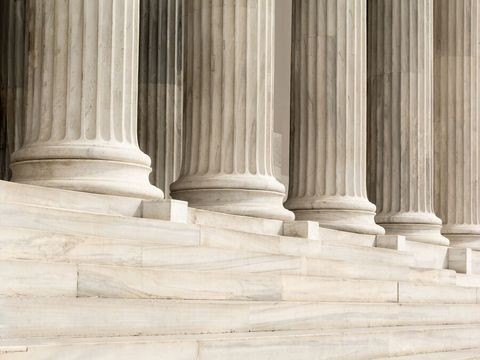The House Passes the Equality Act (Yet Again)
Client Alert | 2 min read | 03.02.21
On February 25, 2021, the U.S. House of Representatives, voting largely along party lines, passed the Equality Act, a bill that if enacted into law would significantly expand the rights of LGBTQ individuals. Specifically, the bill would amend Title VII of Civil Rights Act, as well as other statutes, to explicitly prohibit discrimination based on sexual orientation and gender identity. While President Biden has expressed public support for the Equality Act, it faces an uphill battle before the U.S. Senate, at least as it is currently constituted, because it expressly limits the degree to which the Religious Freedom Restoration Act (RFRA) can be used to defend against claims of unlawful discrimination against gay, lesbian, transgender and bisexual individuals.
What Does the Equality Act Cover?
While the Equality Act has been introduced several times before, and passed in the House back in 2019, the legal landscape has since changed with the Supreme Court’s 2020 decision in Bostock v. Clayton County, which extended Title VII’s protections against sex discrimination to lesbian, gay, and transgender Americans. Rather than include the gender identity and sexual orientation under the umbrella of “sex,” as the Supreme Court did in Bostock, the Equality Act would enshrine nondiscrimination prohibitions relating to sexual orientation and gender identity into law and would significantly expand the protections against discrimination, including harassment, on these bases. Specifically, the Equality Act would cover discrimination in employment, housing, education, credit, federally funded programs as well as expand the definition of "public accommodations,” which would apply to hotels, restaurants, retail stores, banks, gas stations, transportation services, and health care, accounting and legal services. In addition, the Equality Act expressly provides that where sex is a bona fide occupational qualification (BFOQ) for a position, employees will qualify for such a position based on their gender identity, rather than on their biological sex.
The Limitation of Religion as a Shield Against Discrimination Claims
The Equality Act explicitly states that the Religious Freedom Restoration Act (RFRA), which became law in 1993, cannot be used to challenge the Act's provisions or be used as a defense to a claim of unlawful discrimination under the Act. While the Equality Act would limit religion as a defense to discrimination claims, businesses would still retain certain faith-based defenses. For example, religious schools and houses of worship could continue to rely on the “ministerial exemption” which provides an affirmative defense to the application of federal discrimination laws, such as Title VII, the Age Discrimination in Employment Act, the Equal Pay Act, and the Americans with Disability Act, to claims involving the employment relationship between a religious institution and its ministers or others who perform vital religious duties at the core of its mission.
The Likely Road Ahead
The Equality Act faces an uncertain path in the U.S. Senate, as it will be unlikely to pass as currently written. A few Republican Senators, including Mitt Romney and Susan Collins have already indicated they would not support the legislation if offered in its present form. And the bill is unlikely to garner the 60 votes in the Senate that would be necessary to overcome a filibuster. Accordingly, there remains much to be done before the Equality Act becomes law.
Contacts
Insights
Client Alert | 5 min read | 12.12.25
Eleventh Circuit Hears Argument on False Claims Act Qui Tam Constitutionality
On the morning of December 12, 2025, the Eleventh Circuit heard argument in United States ex rel. Zafirov v. Florida Medical Associates, LLC, et al., No. 24-13581 (11th Cir. 2025). This case concerns the constitutionality of the False Claims Act (FCA) qui tam provisions and a groundbreaking September 2024 opinion in which the United States District Court for the Middle District of Florida held that the FCA’s qui tam provisions were unconstitutional under Article II. See United States ex rel. Zafirov v. Fla. Med. Assocs., LLC, 751 F. Supp. 3d 1293 (M.D. Fla. 2024). That decision, penned by District Judge Kathryn Kimball Mizelle, was the first success story for a legal theory that has been gaining steam ever since Justices Thomas, Barrett, and Kavanaugh indicated they would be willing to consider arguments about the constitutionality of the qui tam provisions in U.S. ex rel. Polansky v. Exec. Health Res., 599 U.S. 419 (2023). In her opinion, Judge Mizelle held (1) qui tam relators are officers of the U.S. who must be appointed under the Appointments Clause; and (2) historical practice treating qui tam and similar relators as less than “officers” for constitutional purposes was not enough to save the qui tam provisions from the fundamental Article II infirmity the court identified. That ruling was appealed and, after full briefing, including by the government and a bevy of amici, the litigants stepped up to the plate this morning for oral argument.
Client Alert | 8 min read | 12.11.25
Director Squires Revamps the Workings of the U.S. Patent Office
Client Alert | 8 min read | 12.10.25
Creativity You Can Use: CJEU Clarifies Copyright for Applied Art
Client Alert | 4 min read | 12.10.25
Federal Court Strikes Down Interior Order Suspending Wind Energy Development




